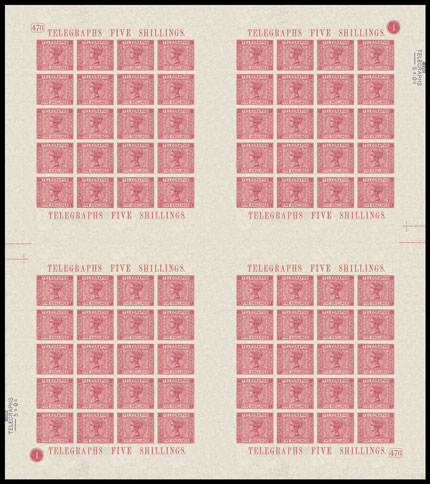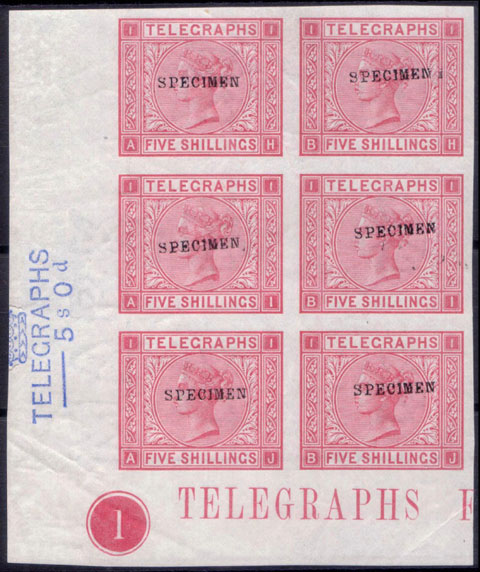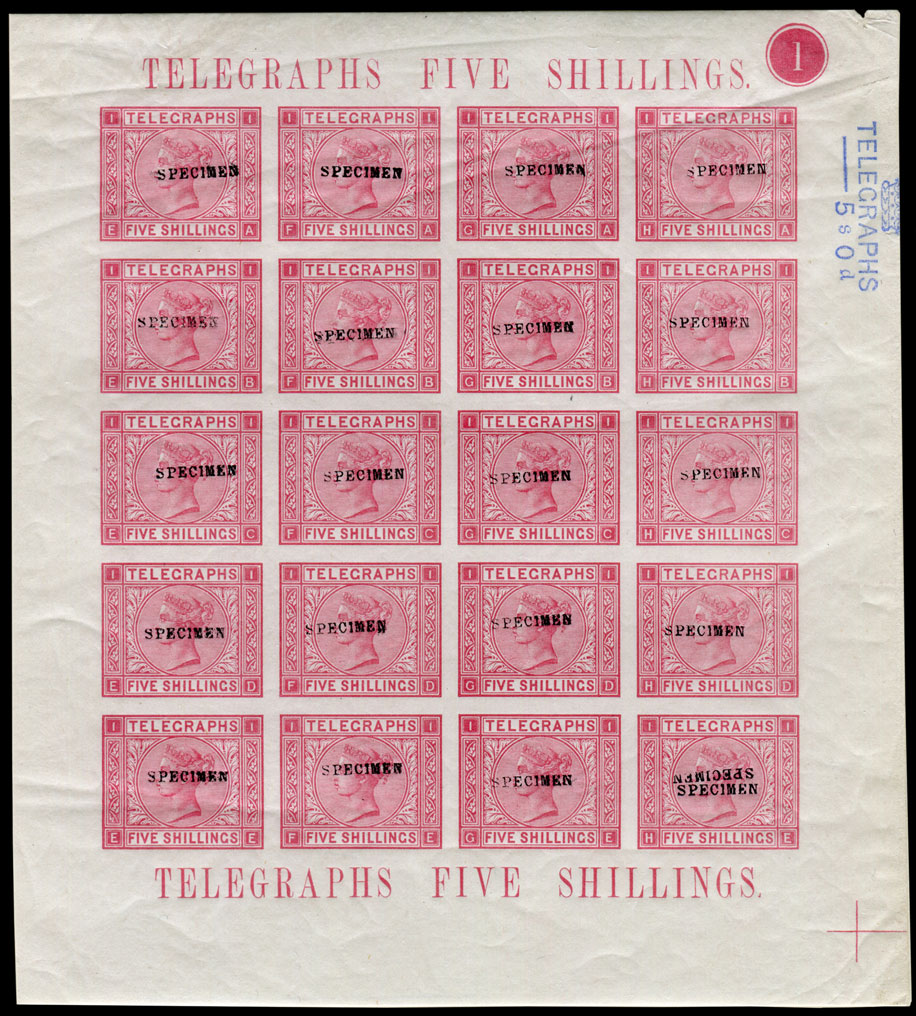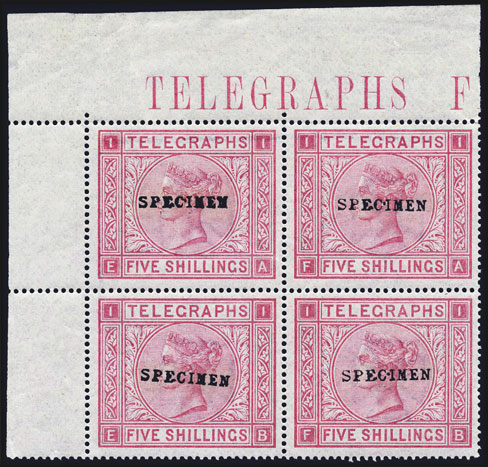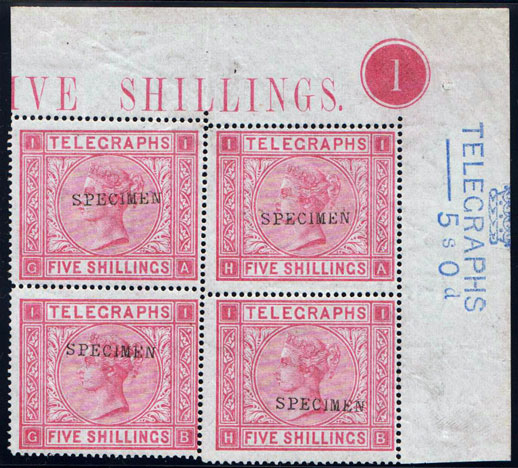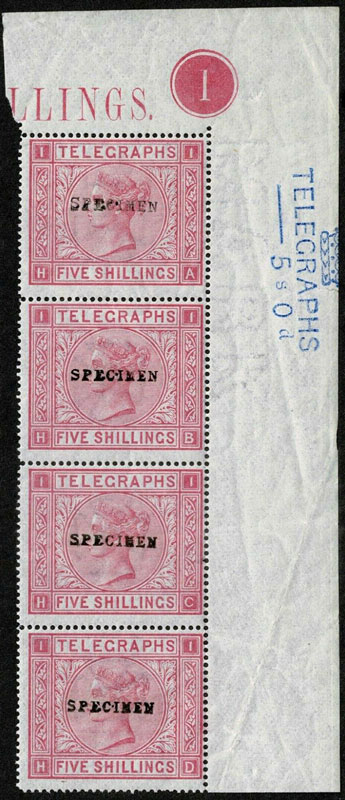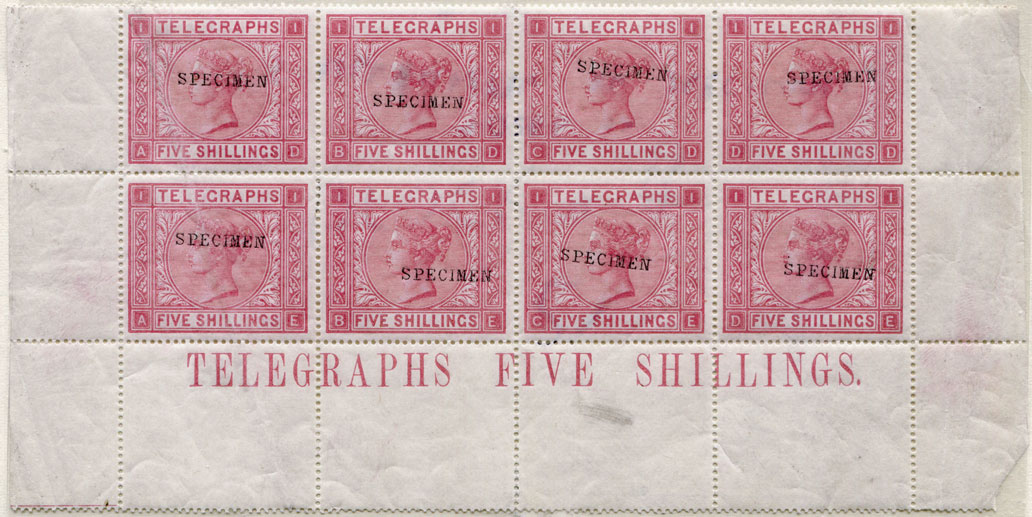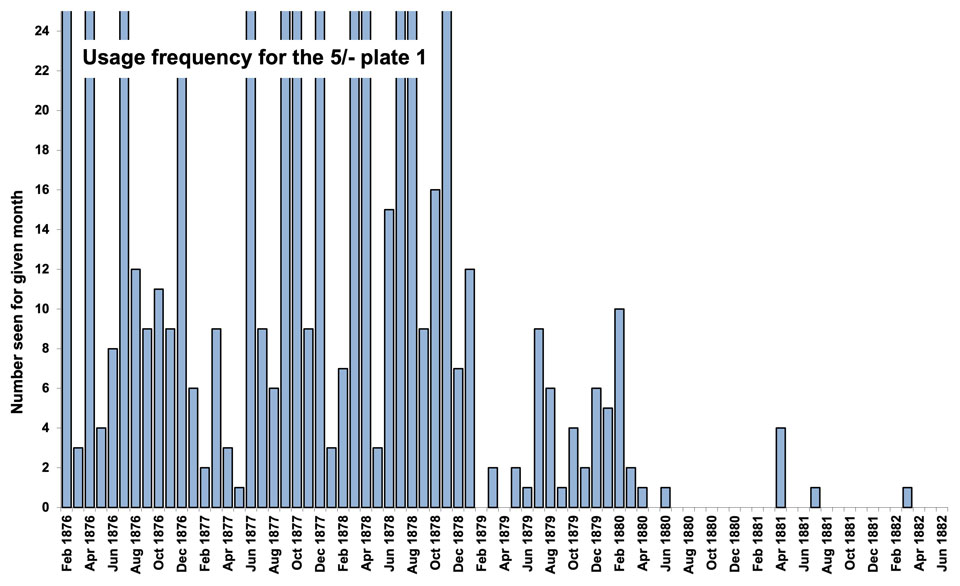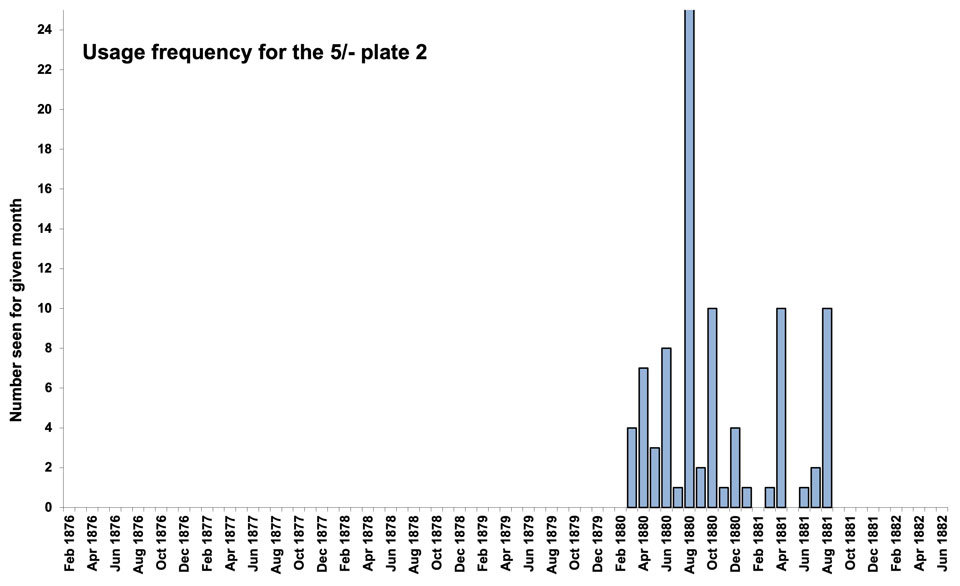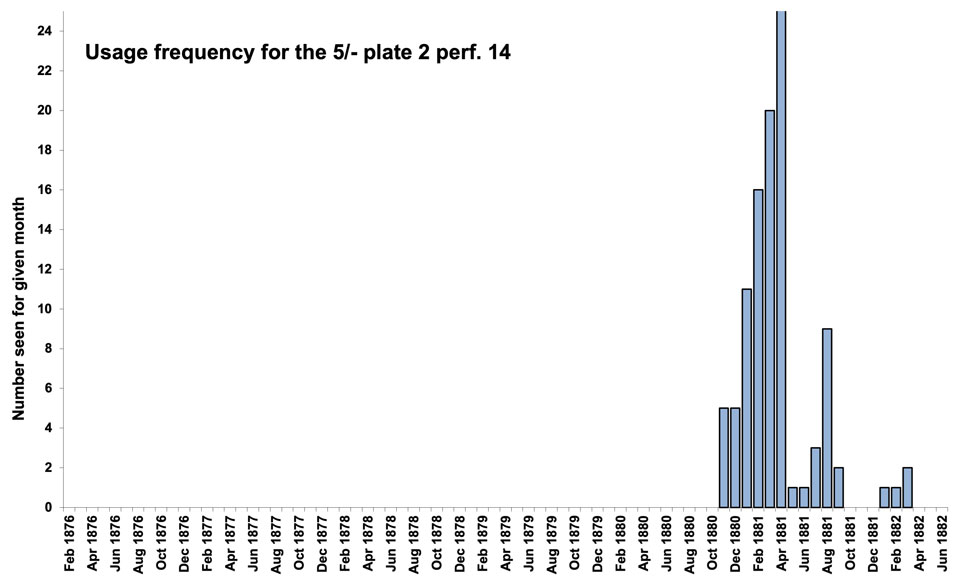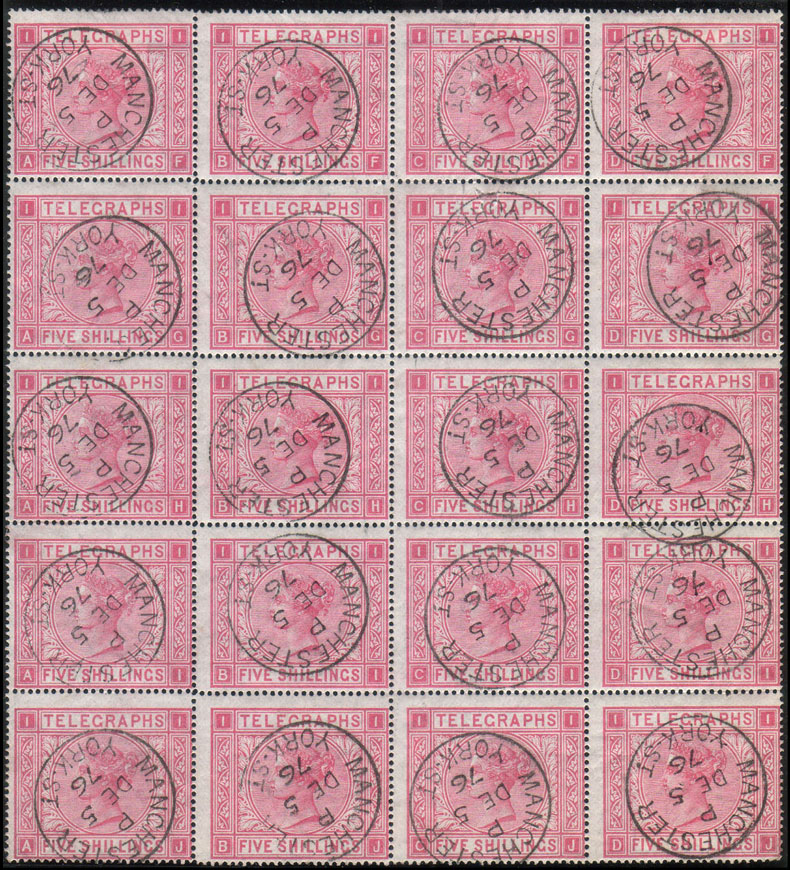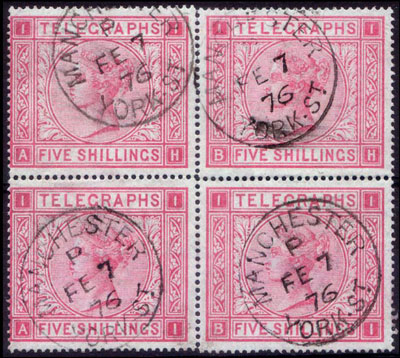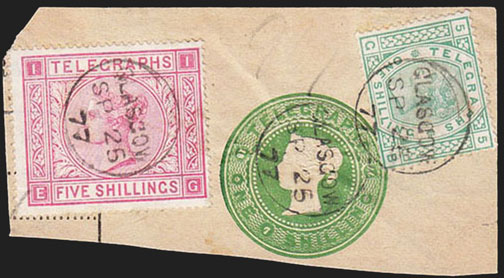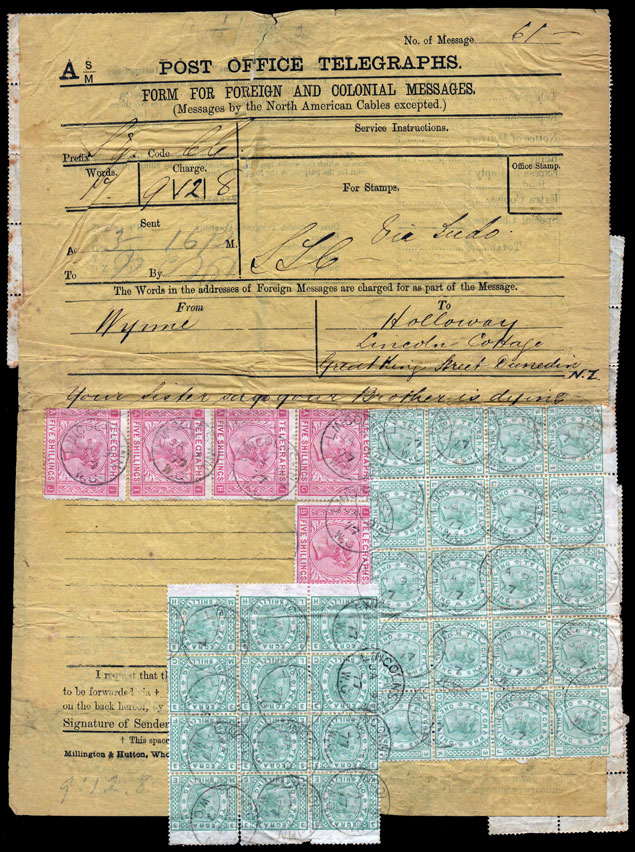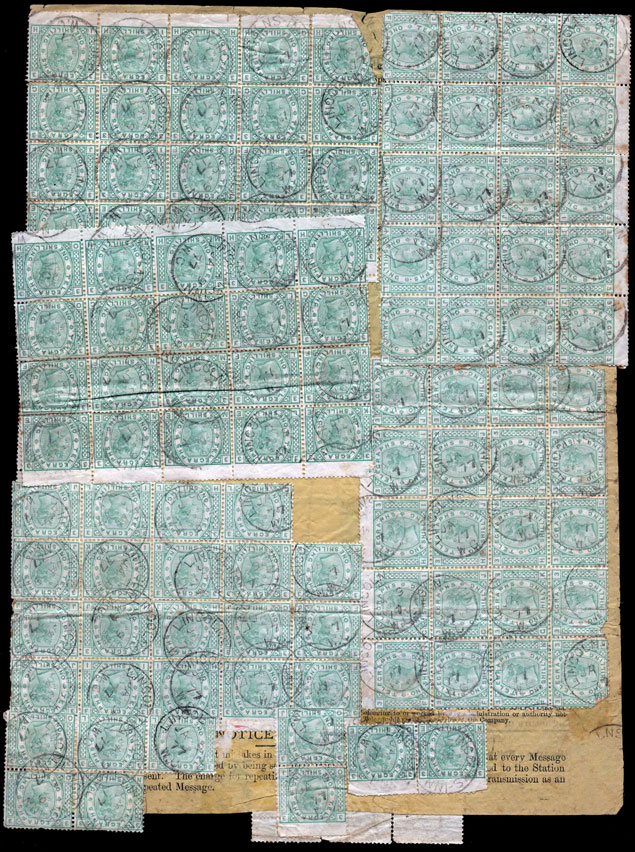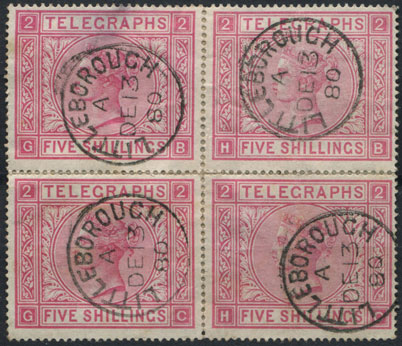1 Essays
2 Die Proofs
3 Sheet Layout
4 Plate Proofs
5 Paper
6 Imprimaturs
7 Colour Standards
8 Specimens
9 Issued Stamps
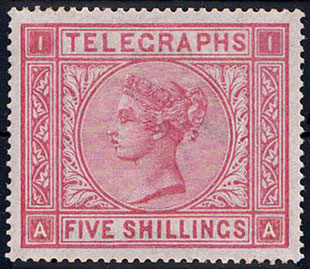
Date: 1 Feb 1876
Plates: 1-3
Printer: De La Rue
Watermark: Maltese Cross
Perforation: 15×15½
The 5s Telegraphs was issued on 1 Feb 1876 together with 1d, 3d, and 1s values. However, no example of any telegraph stamp has been found dated earlier than 4 Feb 1876.
It had been decided that telegraph stamps of the same value as postage stamps would be printed in the same colour and on the same paper as the corresponding postage stamps, hence this stamp was printed in rose on Maltese Cross paper.
Three plates were prepared and registered, imprimaturs exist from all three on Maltese Cross paper. Plate 2 was converted to perforation 14 part way through its print run when the perforation process was transferred from Somerset House to De La Rue on 1 Sept 1880. Plate 3 was put to press on Large Anchor paper. Only the registration sheets were printed from plate 3 on Maltese Cross.
Essays
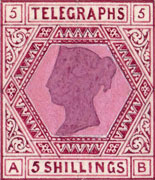
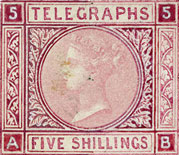
Two essays for the 5s value were prepared by De La Rue for the first issue: Series B dated “24 MAR 75”, and the approved design submitted on 31 Mar 1875. No 5s essay is known from Series A, but it is possible that one was prepared and has been lost.
| B | 5s | 55 | AB | magenta (head in silhouette) |
| C | 5s | 55 | AB | lake, approved design |
For more details on first issue essays click here.
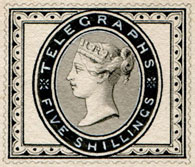
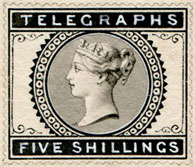
These are from a set of 12 black & white essays which are undated but believed to be circa 1880. Their purpose is not known, but they are likely not related to the issued stamps.
| — | 5s | — | — | black & white |
| — | 5s | — | — | black & white |
For more details on additional essays click here.
Die Proofs
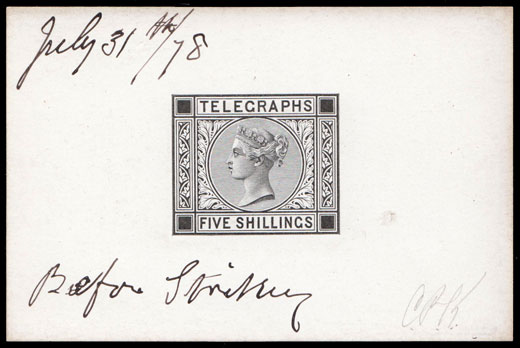
To see more 5s Die Proofs click here.
| June 16, 1875 | — | — | Date altered from June 19 | 0 + 1 |
| June 17, 1875 | — | — | — | 2 |
| June 18, 1875 | — | — | — | 3 |
| June 23, 1875 | — | — | — | 1 |
| June 25, 1875 | — | — | “BEFORE HARDENING” | 3 + 1 |
| July 2, 1875 | — | — | “AFTER STRIKING”, “SEJ” | 0 + 1 |
| no date | — | — | Basic Die Proof | 0 + 1 |
| no date | — | — | Cut down to stamp size | 1 |
| July 31, 1878 | — | — | “CPK” | 0 + 1 |
| July 31, 1878 | — | — | “Before Striking”, “CPK” | 1 |
From the Striking Books
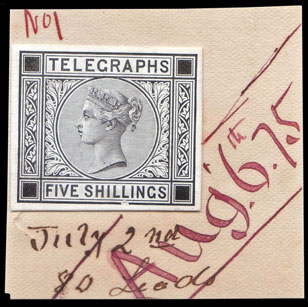
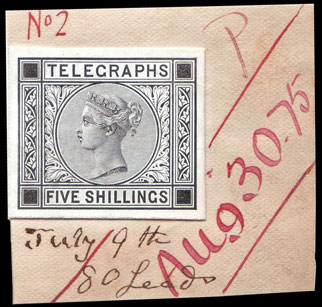
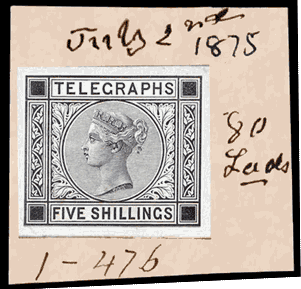
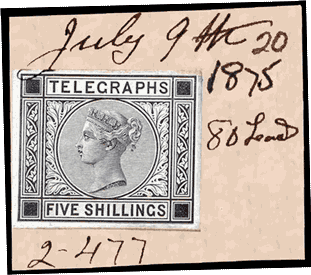
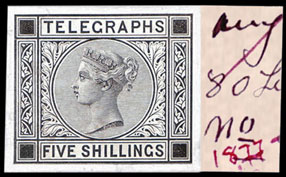
| July 2, 1875 | 1 | — | “July 2 / 80 Leads”, “No 1 / Aug 6 75” | 1 |
| July 9, 1875 | 2 | — | “July 9 / 80 Leads”, “No 2 / Aug 30 75” | 1 |
| July 2, 1875 | 1 | — | “July 2 / 80 Leads / 1-476” | 0 + 1* |
| July 9, 1875 | 2 | — | “July 9 / 80 Leads / 2-477” | 0 + 1* |
| Aug 1877 | 3 | — | “Aug / 80 Le… / No”, “1877” | 1† |
* Langmead Collection — reconstruction.
† Reconstruction.
In a Countersunk Frame
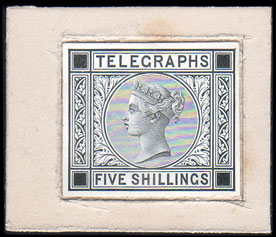
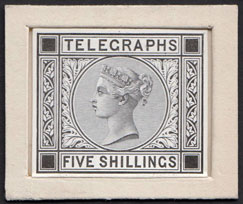
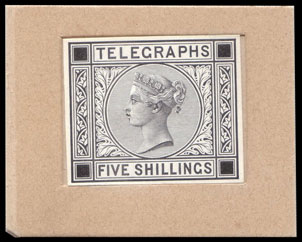
| no date | — | — | Cut down, set in a countersunk frame | 4 |
The Robson Lowe sale on 29 Sept 1976 had two examples of each value from 1d to £5, except for the 5s which had four examples.
Sheet Layout
The sheet had 80 stamps in four panes, arranged two by two. Each pane had 20 stamps in five rows of four. Above and below each pane was “TELEGRAPHS FIVE SHILLINGS.”. Plate numbers were in the upper right and lower left corners, current numbers in the lower right and upper left corners. At the middle of each side was a cross and a horizontal line used as guides for perforating.
A Post Office sheet was one pane, valued at five pounds.
Computer generated image, click to enlarge.
Plate Proofs
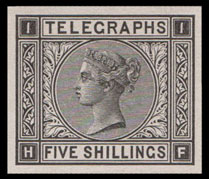
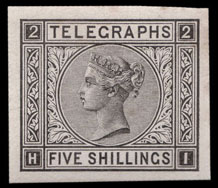
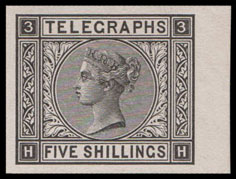
Plate proofs are known for plates 1, 2, and 3. Plate 1 HF is a reconstruction as it is in the Langmead Collection in the British Library. It is from a corner of a pane and is the only one known. Probably unique with no examples available to collectors.
Plate 3 is the most common of the 5s plate proofs. The reconstruction shows there was a block of 10. Two pairs are still intact: GF-HF and GG-HG. A third pair, GH-HH which was owned by H. T. Jackson, has been split.
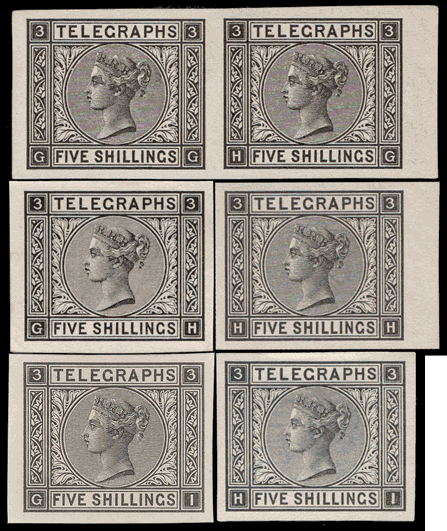
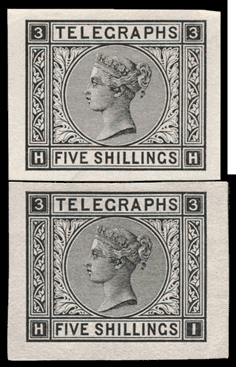
Two copies of HH and HI are known from plate 3, so proofs were taken from two different sheets. We can speculate with some confidence for plate 3 that a block of 10 GF-HJ was taken from one sheet and an additional strip of three HH-HJ was taken from a second sheet. A second HJ is not known but it would have been easier to cut a strip of three rather than a pair from the middle of the column. Since plate 1 and plate 2 examples also come from the H column, we can speculate with less confidence that strips of three were taken from all plates.
Red represents an institutionalised example.
Green a known example in private hands.
Blue is unknown but predicted by the pattern.
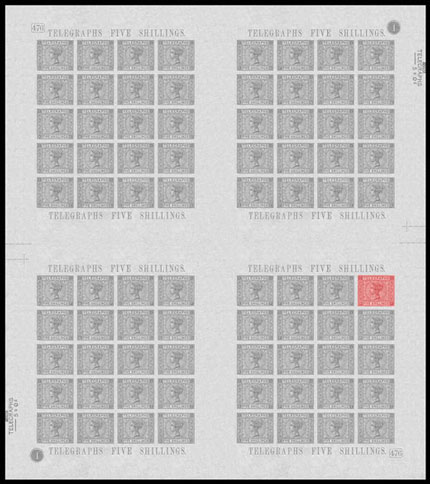
| Institutionalised/Total: | 1/1 |
| Royal Philatelic Collection: | — |
| British Postal Museum: | — |
| Tapling Collection: | — |
| Langmead Collection: | HF |
| Phillips Collection: | — |
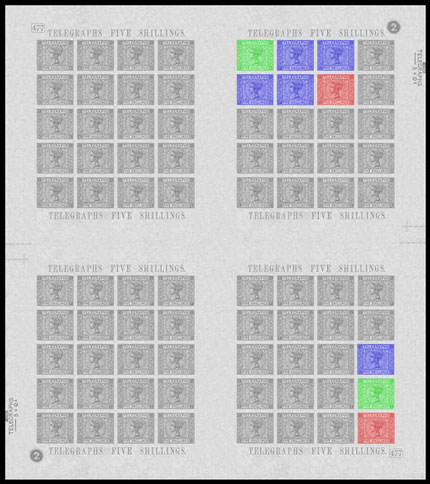
| Institutionalised/Total: | 2/9 |
| Royal Philatelic Collection: | GB |
| British Postal Museum: | — |
| Tapling Collection: | — |
| Langmead Collection: | HJ |
| Phillips Collection: | — |
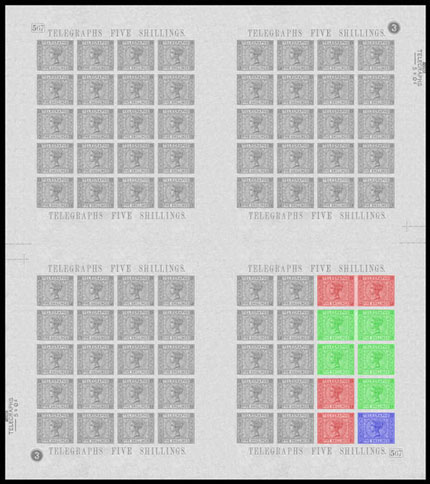
| Institutionalised/Total: | 4/10 |
| Royal Philatelic Collection: | GF-HF |
| British Postal Museum: | — |
| Tapling Collection: | — |
| Langmead Collection: | GJ |
| Phillips Collection: | GI |
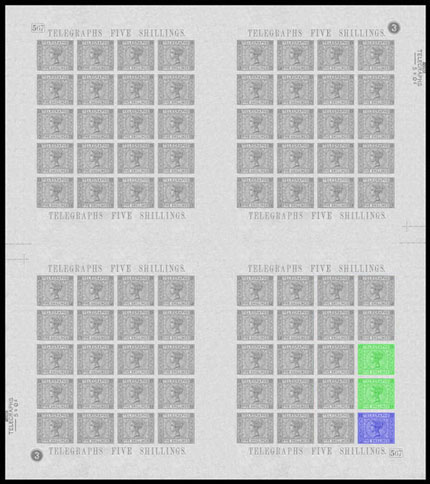
| Institutionalised/Total: | — |
| Royal Philatelic Collection: | — |
| British Postal Museum: | — |
| Tapling Collection: | — |
| Langmead Collection: | — |
| Phillips Collection: | — |
Paper
The 5s telegraph stamp was printed on the same paper as the corresponding postage stamp. It was printed on Maltese Cross paper.
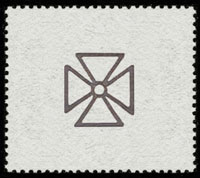
For more details on Maltese Cross paper click here.
Imprimaturs
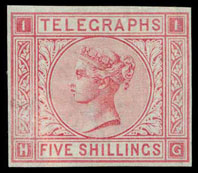
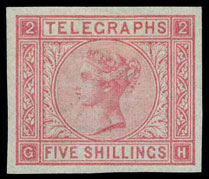
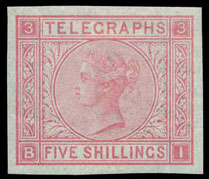
Plates 1 to 3 were registered on 5 Aug 1875, 30 Aug 1875, and 14 Oct 1878.
(A typo in Wright & Creeke has “4.10.78” instead of “14.10.78”)
The registration sheets for the Telegraphs have been lost. We can reconstruct them from known examples; however, the pattern that emerges for the high values is not as clear as that for the low values.
The low values generally have a column of 12 taken, plus four from the adjacent column, and a plate number example from the opposite corner. One sheet of each value has an extra column of 12 taken. The 5s are similar with an irregular block of 16 taken, a plate number example, and an extra 12 from plate 3.
Plate 1 has a pair EH-EI that doesn’t fit the pattern. Plate 3 has a block of four CF-DG, and a pair CH-DH. Plate 3 BH in the Royal Philatelic Collection is perforated on three sides only and is possibly from the registration sheet.
Red represents an institutionalised example.
Green a known example in private hands.
Blue is unknown but predicted by the pattern.
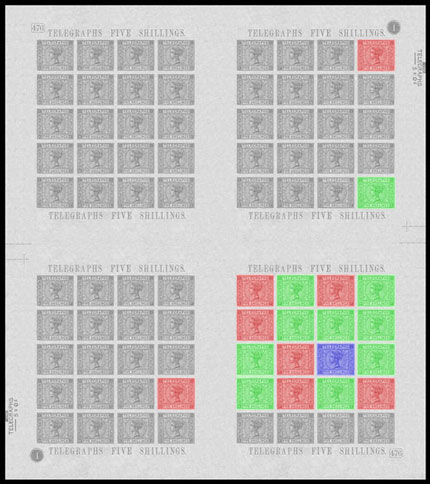
| Institutionalised/Total: | 8/19 |
| Royal Philatelic Collection: | EG, HA |
| British Postal Museum: | DI, EF |
| German Postal Museum: | — |
| Tapling Collection: | HI |
| Langmead Collection: | FH |
| Phillips Collection: | FI, GF |
| Fletcher Collection: | — |
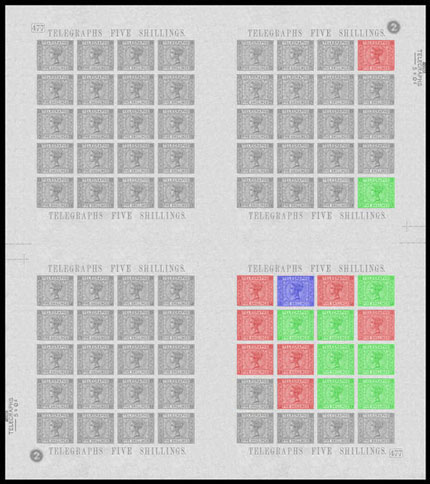
| Institutionalised/Total: | 8/17 |
| Royal Philatelic Collection: | EG, HA |
| British Postal Museum: | EF, EH |
| German Postal Museum: | — |
| Tapling Collection: | HG |
| Langmead Collection: | FI |
| Phillips Collection: | FH, GF |
| Fletcher Collection: | — |
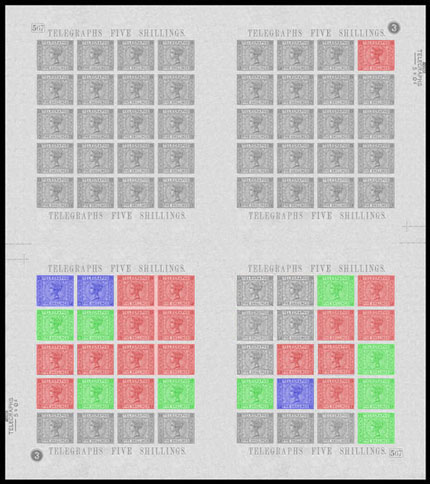
| Institutionalised/Total: | 17/29 |
| Royal Philatelic Collection: | CH-DH, GH, HA |
| British Postal Museum: | FH, GG |
| German Postal Museum: | AH |
| Tapling Collection: | CI |
| Langmead Collection: | CF-DG, GI |
| Phillips Collection: | HF, HG |
| Fletcher Collection: | AI |
Colour Standards
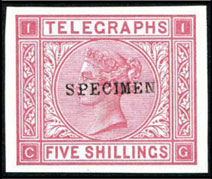
One complete sheet came on to the market in the 1930s: plate 1, imperforate, overprinted Specimen Type 9 horizontally. The stamps are mostly in blocks and scarce as singles, although recently two blocks of eight have been heavily split.
Red represents an institutionalised example.
Green a known example in private hands.
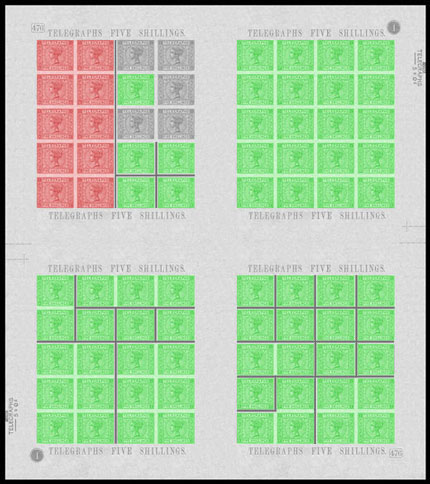
Block AA-BE is in the Langmead Collection.
Click the images to enlarge.
Specimens
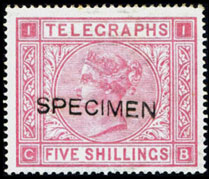
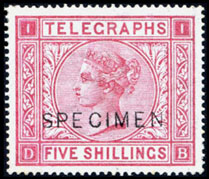
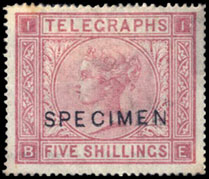
Plate 1 Type 8: scarce, from 3 panes (AE-DE x3), all singles.
Plate 1 Type 10: from contemporary “sets”, scarce, from 4 panes (AA-DE x3, EF-HJ), all singles.
Plate 1 Type 10a: sub-type not previously described, only one seen lettered BE.

Type 10a (top) is the same width as Type 10 (bottom) but is shorter in height.
The ‘C’ is more rounded and the ‘M’ more open.
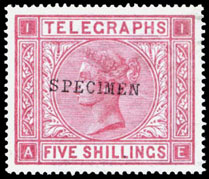
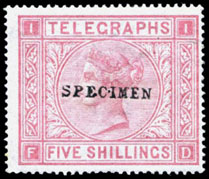
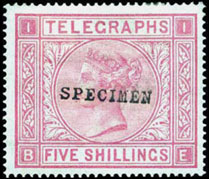
Plate 1 Type 9: common, from 8 panes (AA-DE x3, EA-HE x2, AF-DJ x3), three pairs, blocks of 4 (x2) and 8 (x2) known.
Plate 1 Type 9b: scarce, from 5 panes (EA-HE x5), one pair, a strip of 4, and a block of 4 known.
Plate 1 Type 9c: rare, from 1 pane (EA-HE), only 3 seen.
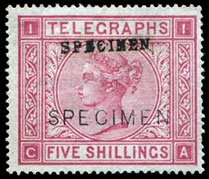
Plate 1 Type 9b and Type 10: rare, two copies known, CA and BD (Langmead Collection).
Click the images to enlarge.
Reference to scarcity, blocks and the number of sheets or panes so treated is derived from reconstructions of known examples within our database.
Issued Stamps
Stamps were issued from plates 1 and 2. Plate 3 was registered but not put to press on Maltese Cross paper.
The usage frequency graphs show the period of plate 1 usage was long. There is no graph for plate 3 on Maltese Cross as only two examples are known.
Click the graphs to enlarge.
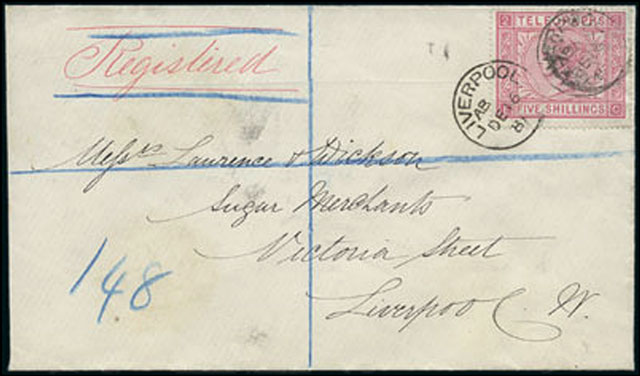
For postal, fiscal, and railway usage click here.
Issued Stamps — Plate 1
Plate 1 (current no. 476) was registered on 5 Aug 1875 and approved on 9 Aug 1875. It was put to press on 5 Aug 1875 and taken from press on 24 May 1878 after printing 35,000 sheets.
Scarcity #22 in mint telegraphs, #1 in used telegraphs.
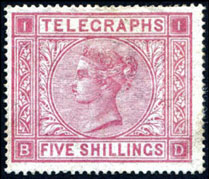
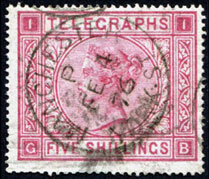
No mint multiples are known to us.
Used stamps are common, the most common of used telegraphs. Three complete reconstructed sheets are known to us. Used multiples are common with 67 pairs, 10 strips of three, three strips of four, 11 blocks of four, blocks of 5, 6, 8 (x2), 10 (x2), 12, and a pane of 20 in our database. The earliest known used example is 4 Feb 1876 at several locations on this date, Manchester York Street being the most common (illustrated).
Inverted watermarks probably exist but cannot be distinguished on Maltese Cross paper.
Click the images to enlarge.
This telegraph form was sent from London to New Zealand in January 1877. The telegram cost a staggering £9-12-8 for just a seven word message. The price was calculated based on ten words in the addresses plus seven words in the message: 17 words at 11/4d each word. Unfortunately, some stamps have been removed and others re-affixed in different positions, although this does not detract from this incredibly rare survivor. The telegram pre-dates the second issue and clearly shows the need for high values.
Click the images to enlarge.
Issued Stamps — Plate 2
Plate 2 (current no. 477) was registered on 30 Aug 1875 and approved on 23 Sept 1875. It was put to press on 31 Dec 1879 and taken from press on an unknown date after printing 5,000 sheets.
Scarcity #35 in mint telegraphs, #30 in used telegraphs.
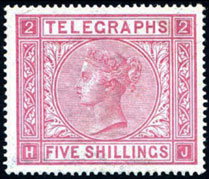
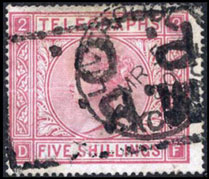
No mint multiples are known to us.
Used stamps are rare, more so than the perf 14 below, although the catalogue price suggests otherwise. Two pairs and a reconstructed block of four singles are known to us. The earliest known used example is 5 Mar 1880 at Liverpool Exchange (illustrated).
Click the image to enlarge.
Issued Stamps — Plate 2 (perf 14)
Plate 2 was converted to perforation 14 part way through its print run when the perforation process was transferred from Somerset House to De La Rue on 1 Sept 1880.
Scarcity #36 in mint telegraphs, #29 in used telegraphs.
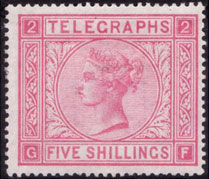
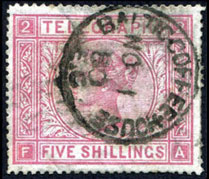
No mint multiples are known to us.
Used stamps are scarce. Used multiples in our database include two pairs and a strip of three. The earliest known used example is 1 Nov 1880 at Baltic Coffee House (Threadneedle St) (illustrated). A 1937 Robson Lowe auction catalogue describes a block of 16 with a “Keighley P” cds on each stamp, the same as the strip of three. This block may have been split, but there could still be a block of 12.
Click the image to enlarge.
Issued Stamps — Plate 3
Plate 3 (current no. 567) was registered on 14 Oct 1878 but not put to press on Maltese Cross paper. Only the registration sheets were printed.
One mint example lettered BH is in the Royal Philatelic Collection (illustrated below). It is perforated on three sides only and is possibly from the registration sheet.
One used example lettered CE is in the Royal Philatelic Collection (illustrated below). It is roughly perforated 12½ and dated 13 Jan 1881 in Edinburgh. As with the 3d plate 4 on Spray, it is likely that this is from extra registration sheets which were perforated and issued.
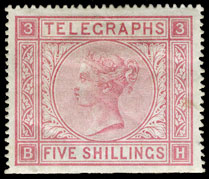
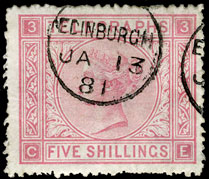
Royal Philatelic Collection.
Reproduced by gracious permission of Her Majesty The Queen to whom copyright belongs.
Jackson, and subsequently the SG Specialised, says that two examples of Plate 3 are known perforated 12½, but we believe this is an error originating from the British Philatelist, Vol VII, No 2, pp17-18, where the author describes “an important find” of the used example above now in the RPC, but then mentions “a single used copy … in Lord Crawford’s collection”. However, Lord Crawford’s Telegraphs are now in the RPC and the “used” copy must be the mint copy above. Confusion caused by an extra word — “used”?
